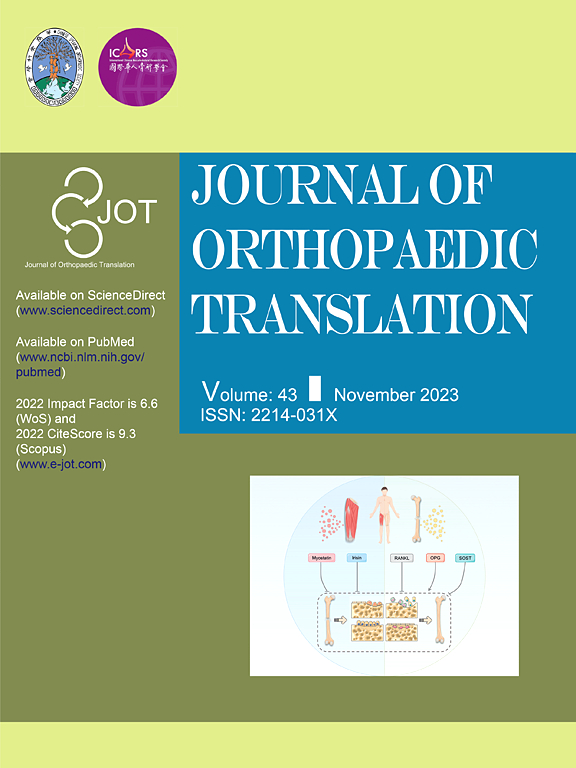靶向激活Bnip3增强线粒体自噬以预防骨关节炎的进展
IF 5.9
1区 医学
Q1 ORTHOPEDICS
引用次数: 0
摘要
在骨关节炎(OA)过程中,软骨细胞中活性氧(ROS)的产生和线粒体功能障碍与软骨退变密切相关。线粒体自噬负责清除活性氧和功能失调的线粒体,被认为是OA治疗的关键治疗靶点。硫普罗宁是一种经典的硫醇类抗氧化剂,已被广泛研究用于治疗各种氧化应激相关疾病。方法采用Western blot和组织学分析方法分析OA患者完整和损伤软骨中线粒体自噬(PINK1、PARKIN、TOMM20)的表达情况。通过RNA测序(RNA-seq)分析,探讨tiopronin调节软骨细胞线粒体自噬的分子机制,进而寻找tiopronin的特异性靶点。通过内侧半月板失稳所致OA模型、小鼠原代软骨细胞退行性软骨细胞模型和人软骨外植体实验,评价了tiopronin的治疗效果。通过下调有丝分裂相关蛋白的si-RNA,进一步研究了tiopronin的下游分子机制。结果软骨自噬水平与骨性关节炎严重程度呈负相关。我们发现,硫普罗宁促进透明软骨细胞的细胞外基质(ECM)的合成代谢,并通过加强线粒体自噬来减轻体内和体外的ROS。此外,tiopronin强烈激活Bnip3的表达,Bnip3是一种锚定在线粒体膜上的蛋白,随后增强了Pink1/Parkin信号通路。结论Bnip3-Pink1-Parkin信号通路被tiopronin靶向并激活,在抑制OA进展中起关键作用。硫普罗宁作为临床上的经典药物,本研究为OA的治疗开辟了一条新的途径。鉴于tiopronin在抑制骨性关节炎软骨变性和延缓骨性关节炎进展方面具有显著而有效的作用,我们认为tiopronin可能成为临床治疗骨性关节炎的有效候选药物本文章由计算机程序翻译,如有差异,请以英文原文为准。

Targeted activation on Bnip3 enhances mitophagy to prevent the progression of osteoarthritis
Background
The production of reactive oxygen species (ROS) and mitochondrial dysfunction in chondrocytes are closely related to cartilage degeneration in the procedure of osteoarthritis (OA). Mitophagy is responsible for the scavenging of ROS and dysfunctional mitochondria and is considered a key therapeutic target for the treatment of OA. Tiopronin, a classic thiol antioxidant, has been widely studied for the treatment of various oxidative stress-related diseases.
Methods
The expression of mitophagy (PINK1, PARKIN, and TOMM20) in intact and damaged cartilage of OA patients was analyzed by Western blot and histological analysis. RNA sequencing (RNA-seq) analysis was performed to explore the molecular mechanism of tiopronin in regulating mitophagy in chondrocytes, and then to find the specific target of tiopronin. The therapeutic effects of tiopronin were evaluated in the OA model induced by destabilisation of the medial meniscus (DMM), chondrocytes degenerative model with the primary chondrocytes from mouse and human cartilage explants experiment. The downstream molecular mechanisms of tiopronin were further investigated by si-RNA knockdown of mitophagy-related proteins.
Results
The level of mitophagy in cartilage was negatively correlated with the severity of OA. We revealed that tiopronin promoted the anabolism of the extracellular matrix (ECM) of hyaline chondrocytes and alleviates ROS in vitro and in vivo by strengthening mitophagy. Moreover, tiopronin strongly activated the expression of Bnip3, a protein anchored in the mitochondrial membrane, and subsequently enhanced the Pink1/Parkin signaling pathway.
Conclusion
These findings indicate that the Bnip3-Pink1-Parkin signaling pathway, targeted and activated by tiopronin, plays a key role in inhibiting the progression of OA.
The translational potential of this article
As a classical drug in clinic, tiopronin was developed a new therapeutic approach in the treatment in OA via this study. Based the significant and efficient effect of tiopronin in inhibiting the cartilage degermation and delay the progression of OA, it was believed that tiopronin may become an effective therapeutic candidate for OA treatment in clinical settings
求助全文
通过发布文献求助,成功后即可免费获取论文全文。
去求助
来源期刊

Journal of Orthopaedic Translation
Medicine-Orthopedics and Sports Medicine
CiteScore
11.80
自引率
13.60%
发文量
91
审稿时长
29 days
期刊介绍:
The Journal of Orthopaedic Translation (JOT) is the official peer-reviewed, open access journal of the Chinese Speaking Orthopaedic Society (CSOS) and the International Chinese Musculoskeletal Research Society (ICMRS). It is published quarterly, in January, April, July and October, by Elsevier.
 求助内容:
求助内容: 应助结果提醒方式:
应助结果提醒方式:


